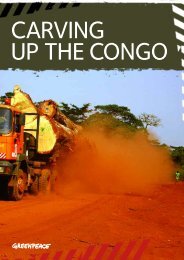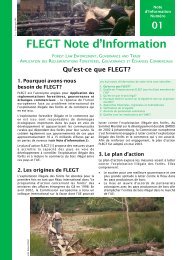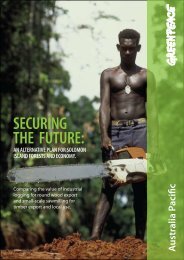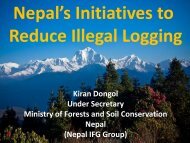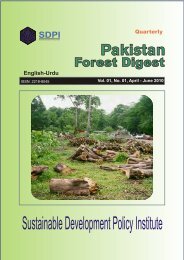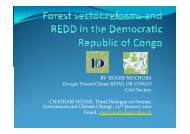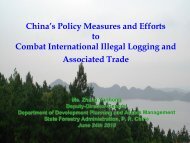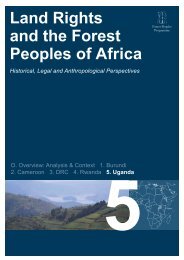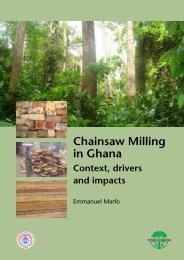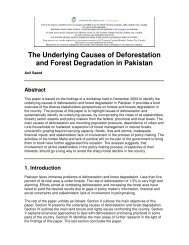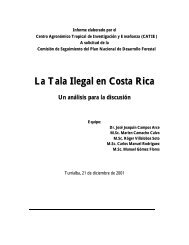conflict over natural resources at the community level in nepal
conflict over natural resources at the community level in nepal
conflict over natural resources at the community level in nepal
You also want an ePaper? Increase the reach of your titles
YUMPU automatically turns print PDFs into web optimized ePapers that Google loves.
while poorer CFUG members bear a disproportion<strong>at</strong>e share of <strong>the</strong> management costs. The landless poor areoften excluded from us<strong>in</strong>g forest <strong>resources</strong> th<strong>at</strong> were more available to <strong>the</strong>m under previous open accessregimes. In <strong>the</strong> majority of Community Forest User Groups, management composition and benefitdistribution re<strong>in</strong>forces r<strong>at</strong>her than reduces social <strong>in</strong>equality. On <strong>the</strong> positive side, CFUGs are among <strong>the</strong> fewfunction<strong>in</strong>g democr<strong>at</strong>ic <strong>in</strong>stitutions <strong>in</strong> Nepal <strong>at</strong> <strong>the</strong> current time.Nepal has a diversity of non-timber forest products (NTFPs) <strong>in</strong>clud<strong>in</strong>g arom<strong>at</strong>ic, medic<strong>in</strong>al, food, and fiberplants. Many of <strong>the</strong>se species grow <strong>in</strong> <strong>the</strong> hills and mounta<strong>in</strong>s, provid<strong>in</strong>g an important supplementallivelihood resource for families who can grow only enough crops to feed <strong>the</strong>mselves for a few months of <strong>the</strong>year. Wild plants are <strong>the</strong> only source of medic<strong>in</strong>e for many rural families. HMGN taxes valuable NTFPs and<strong>the</strong> Maoists are believed to tax almost all NTFP production.WATER RESOURCES AND CONFLICTNepal has a large supply of w<strong>at</strong>er <strong>in</strong> proportion to its size and has <strong>the</strong> potential to produce large quantities ofhydropower because of <strong>the</strong> steep gradient of <strong>the</strong> rivers flow<strong>in</strong>g out of <strong>the</strong> Himalayas. Micro- and small- tomedium-scale hydropower systems have been developed to serve remote communities and urban areas,respectively. Major rivers feed large irrig<strong>at</strong>ion systems <strong>in</strong> <strong>the</strong> Terai and smaller, but older, systems <strong>in</strong> <strong>the</strong> hills.River flow is highly seasonal, which limits irrig<strong>at</strong>ion to one cropp<strong>in</strong>g season per year <strong>in</strong> many places. In <strong>the</strong>hills and mounta<strong>in</strong>s, access to dr<strong>in</strong>k<strong>in</strong>g w<strong>at</strong>er is difficult for many communities, especially <strong>in</strong> <strong>the</strong> dry season.W<strong>at</strong>er pollution has become a significant problem <strong>in</strong> <strong>the</strong> K<strong>at</strong>hmandu Valley and downstream of largefactories <strong>in</strong> <strong>the</strong> Terai.Irrig<strong>at</strong>ion has a very long history <strong>in</strong> Nepal, with well-established traditional <strong>in</strong>stitutions and procedures for <strong>the</strong>management of <strong>the</strong> thousands of Farmer Managed Irrig<strong>at</strong>ion Systems (FMIS) <strong>in</strong> <strong>the</strong> country. Most of <strong>the</strong>FMIS are <strong>in</strong> <strong>the</strong> hills, while G<strong>over</strong>nment Managed Irrig<strong>at</strong>ion Systems (GMIS) <strong>in</strong> <strong>the</strong> Terai commonly c<strong>over</strong>tens of thousands of hectares, with thousands of users. Conflicts can be m<strong>in</strong>imized or managed through goodg<strong>over</strong>nance <strong>in</strong> Irrig<strong>at</strong>ion W<strong>at</strong>er Users Associ<strong>at</strong>ions (IWUA) and good technical design of systems. As is <strong>the</strong>case with <strong>community</strong> forests, wealthier people tend to benefit more and pay proportionally less <strong>in</strong>ma<strong>in</strong>tenance fees and time than poorer users. The poorest farmers <strong>in</strong> <strong>the</strong> Terai do not even own irrig<strong>at</strong>edland but r<strong>at</strong>her farm <strong>the</strong> land of large landowners as sharecroppers or laborers.Only a fraction of <strong>the</strong> hydropower potential of Nepal is developed, but <strong>the</strong> few systems th<strong>at</strong> exist haveproduced significant local social and environmental impacts dur<strong>in</strong>g construction and oper<strong>at</strong>ion, cre<strong>at</strong><strong>in</strong>g<strong>conflict</strong> with people <strong>at</strong> <strong>the</strong> dam site and downstream. Competition to use <strong>the</strong> same w<strong>at</strong>er source for mutuallyexclusive purposes is a localized problem <strong>in</strong> Nepal, <strong>in</strong>volv<strong>in</strong>g <strong>conflict</strong>s between hydropower, irrig<strong>at</strong>ion,dr<strong>in</strong>k<strong>in</strong>g w<strong>at</strong>er, and <strong>in</strong>dustrial use. Transboundary w<strong>at</strong>er use agreements generally favor India, <strong>in</strong>creas<strong>in</strong>g <strong>the</strong>potential <strong>conflict</strong> <strong>over</strong> w<strong>at</strong>er.BIODIVERSITY CONSERVATION AND CONFLICTProtected areas (PAs), especially those <strong>in</strong> <strong>the</strong> Terai, have been a source of <strong>conflict</strong> with communities liv<strong>in</strong>g<strong>in</strong>side and adjacent to <strong>the</strong> parks for decades. Prior to PA establishment, communities grazed livestock, grewcrops and harvested fuelwood, grass, and build<strong>in</strong>g m<strong>at</strong>erial on wh<strong>at</strong> is now protected land. People liv<strong>in</strong>g<strong>in</strong>side protected areas <strong>in</strong> <strong>the</strong> Terai have been resettled and people liv<strong>in</strong>g <strong>in</strong> buffer zones around <strong>the</strong> PAs wereaggrieved by <strong>the</strong> gre<strong>at</strong>ly restricted access to PA <strong>n<strong>at</strong>ural</strong> <strong>resources</strong>, exacerb<strong>at</strong>ed by crop damage and even de<strong>at</strong>hfrom wildlife th<strong>at</strong> wandered out of <strong>the</strong> parks.The Maoists use some PAs as sanctuaries and tra<strong>in</strong><strong>in</strong>g areas, have destroyed some park build<strong>in</strong>gs, forced parkpersonnel out, and killed staff. Conserv<strong>at</strong>ion nong<strong>over</strong>nmental organiz<strong>at</strong>ions (NGOs) <strong>in</strong>dic<strong>at</strong>e th<strong>at</strong> <strong>the</strong>Maoist presence gives buffer zone and with<strong>in</strong>-park communities gre<strong>at</strong>er leverage to demand developmentassistance from <strong>the</strong>ir projects with less commitment to particip<strong>at</strong>e <strong>in</strong> conserv<strong>at</strong>ion activities, mak<strong>in</strong>g it moreCONFLICT OVER NATURAL RESOURCES AT THE COMMUNITY LEVEL IN NEPALvii




